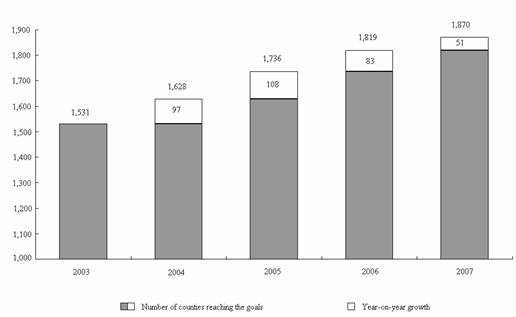Figure 8.
Counties Reaching the Goals in the Plan to Make Nine-year Compulsory Education Universally Available and Basically Eliminate Illiteracy among Young and Middle-aged Adults

Development of a multi-level medical and health service system for both urban and rural residents was accelerated. The government allocated 2.7 billion yuan to support the development of 2,502 health clinics in towns and townships and 514 county-level hospitals, and supply medical equipment to 11,700 town and township health clinics. Availability of community-level health services was raised to 98 percent of all cities at and above the prefecture level, 93 percent of all municipal districts and over 50 percent of all county seats. Continued improvement was made in family planning work. The birthrate remained stable at a low level and the natural population growth rate was 5.17‰.
Development of culture, tourism and sports was accelerated. Work was started to extend radio and TV coverage to every village with electricity and a minimum size of 20 households and to build the fourth phase of the Tibet-Xinjiang Project to extend radio coverage in the western region. Radio coverage now reaches 95.4 percent and television coverage 96.6 percent of the country's population. The trials to build multipurpose cultural centers in towns and townships and the project to set up a national shared database for cultural information and resources progressed smoothly. The National Grand Theater was built and put into operation, and work on key cultural facilities such as the second phase project of the National Library of China, the project to build a facility for the National Theater Company of China and the project to expand the National Museum of China was accelerated. Efforts were strengthened to protect cultural and natural heritage sites. The press and publishing, literature and art, philosophy and social sciences all flourished. Infrastructure for key tourist sites in the early history of the CPC continued to improve. The number of domestic and outbound tourist trips grew by 15.5 percent and 18.6 percent respectively. Great efforts were made to stage sports and exercise activities for the public in connection with the coming Olympics, development of urban and rural public sports facilities was accelerated and construction of 36 Olympic venues was completed.
People received even more tangible benefits. Per capita net income for rural residents rose by 9.5 percent and per capita disposable income for urban residents by 12.2 percent in real terms. Upgrading of the consumption structure was accelerated, consumer spending on cars, tourism, telecommunications and fitness continued to increase, and construction of low-rent housing and commercial housing with price ceilings was accelerated. A total of 12.04 million urban residents entered the workforce in 2007, and the year-end rate of registered urban unemployment was 4 percent. The number of people covered by the social safety net continued to rise, the number of urban residents covered by the basic old-age pension system increased by 13.41 million year on year and old-age pensions for enterprise retirees were raised by a large margin. The trial of providing basic medical insurance for non-working urban residents was launched in 88 cities, with 40.68 million people receiving coverage, and an urban assistance system for medical care was put in place in 2,461 counties (county-level cities and districts). A total of 730 million farmers are now participants in the new system of rural cooperative medical care and the system now covers 86 percent of the country's counties. The system of basic cost of living allowances has now been set up in all rural areas of China. Marked success was achieved in efforts to reduce rural poverty through development and give people work in place of relief subsidies, and 255,000 poor people were relocated from inhospitable areas as a poverty relief effort. Inspections were carried out to monitor the prices of pork, grain and edible oils as well as education-related charges, medical costs and housing prices, a campaign to make price information and oversight services widely available was conducted and the framework of a price monitoring service network that covers both urban and rural areas was put in place.